Crepe myrtle care and growing guide – top tips for these flowering trees
Grow crepe myrtle in your yard with these expert tips on planting, problem solving, and more


Crepe myrtle plants are spectacular, deciduous, flowering shrubs or small trees providing an impressive summer floral display in areas with hot summers, especially in southern states. Drought tolerant when established, many modern varieties are neat enough in growth to make fine container plants, while others develop into dramatic specimen trees suited to suburban gardens, broader landscapes, and city planting. Some are modest in growth and bring a burst of summer color to small yards.
The bark of these fast-growing, flowering trees is often attractively patterned in peeling cream, gray, brown and rusty orange combinations. Tight heads up to 12in long and 6in across are packed with small summer blooms opening in white, pink, lavender, red, or purple tones from early summer into early fall, depending on the area and variety. Some are scented, but not usually strongly. The most widely used common name, crepe myrtle, refers to the crinkled petals, like crepe paper, and either the shape of the neat leaves or the supposed myrtle-like fragrance of the flowers.
What's more, they're one of the best trees for fall color, as their foliage brings red, gold or yellow tones to the backyard, and they can even be grown in pots.
Crepe myrtle is the official state shrub of Texas. Without question, it is the premier flowering tree or shrub for Zones 7-10, the Southeast, Southwest, and into California, says woody-plant expert Michael Dirr in Dirr’s Trees and Shrubs For Warm Climates.

These trees get their name from the flowers, which are reminiscent of crepe paper

Graham has a wealth of knowledge in all things horticulture. He trained at the prestigious Royal Botanic Gardens in Kew, England, and since then has written more than 20 books on plants and gardening and been a judge at Chelsea Flower Show, as well as writing for many gardening magazines and websites. He gardened in Pennsylvania for 20 years, but has recently returned to his native England.
Crepe myrtle key facts:
- Plant type: Deciduous flowering shrub or tree
- Mature size: 3-50ft
- Soil type: Well-drained, fertile soil
- Soil pH: Acid, neutral
- Time of year to plant: Late fall, winter, early spring
- Flowering time of year: Summer, early fall
- Flower color: White, pink, lavender, red, purple
- Hardiness zones: USDA Z7 (above-ground branches), USDA Z5 (roots)
- Scientific name: Lagerstroemia
- Common names: Crepe myrtle, crape myrtle, summer lilac

Crepe myrtles have beautiful blooms in summer
The main types of crepe myrtle
Introduced from China in the eighteenth century, Lagerstroemia indica is the old favorite and the well-known summer lilac or crepe myrtle of southern gardens. Reaching up to 45ft in height, and developing a striking multi-stemmed shape, visiting the south for the first time in summer is to be astonished by the impact of the floral display set off by the dark green foliage. As fall develops, the leaves turn red, orange and yellow shades, creating a whole new season of color. After leaf fall, the colorful bark often provides winter interest. There are many named varieties.
Lagerstroemia faurei was introduced from Japan in the 1950s. Although the flowering is much less colorful than Lagerstroemia indica, it is resistant to the mildew that can disfigure the leaves of Lagerstroemia indica, and its bark is more colorful.
Lagerstroemia hybrids bring together features from the two original Asian species and, in particular, this has led to the development of many colorful and disease-resistant varieties. So, recently, these hybrids have been planted more often.
Design expertise in your inbox – from inspiring decorating ideas and beautiful celebrity homes to practical gardening advice and shopping round-ups.
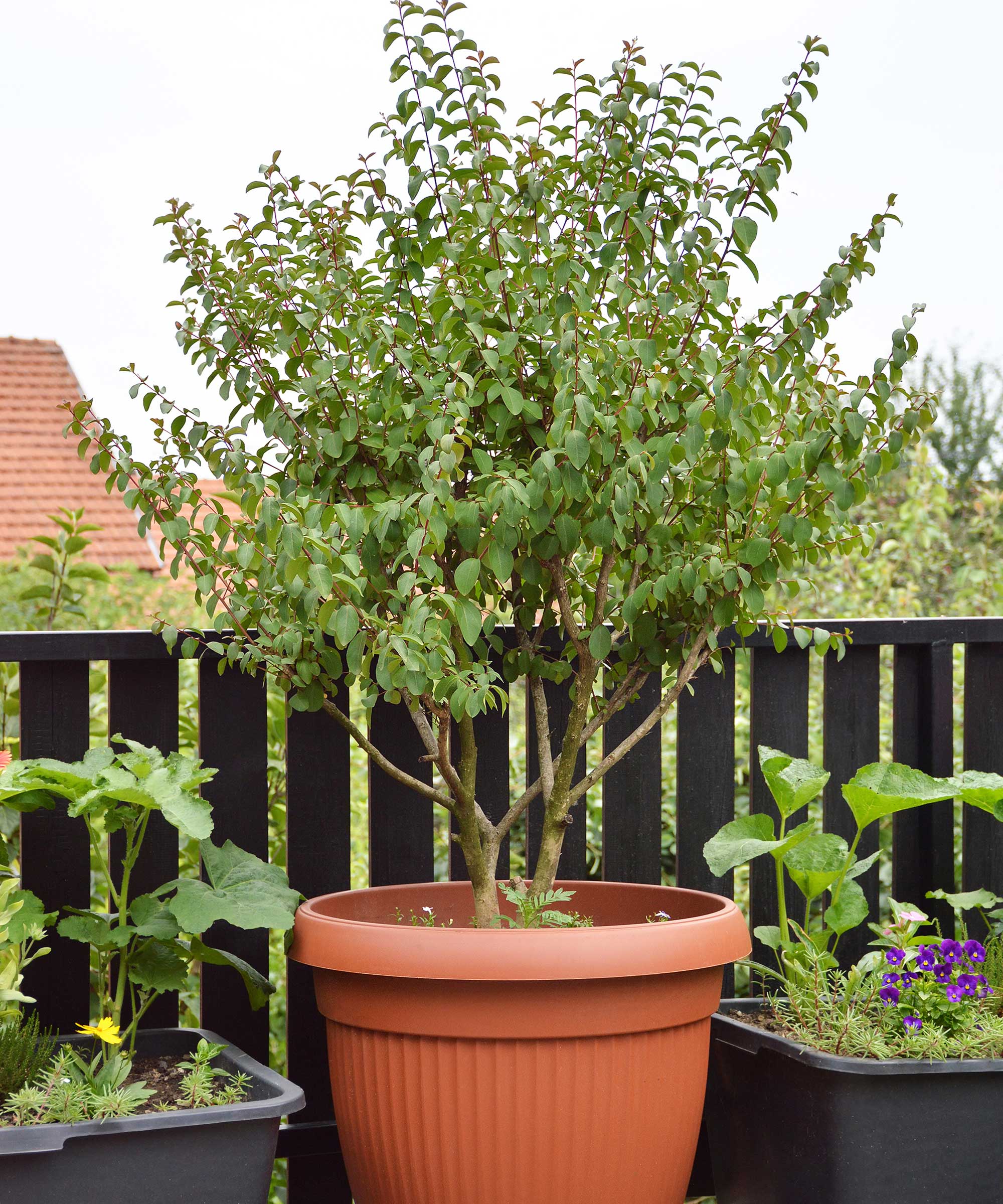
Some smaller varieties are well-suited to containers
How to choose a crepe myrtle for your backyard
'White, pink, red, or purple blooms, attractive foliage, and exfoliating bark have made crepe myrtles a mainstay of southern landscapes for many years, and now you can enjoy their beauty no matter how small your garden,' say the experts at Wayside Gardens.
Start by choosing from the mildew-resistant varieties now available. These include 'Natchez' (white) and ‘Apalachee’ (lavender).
Matching the eventual size of the plant as it matures to the situation you have in mind is also important. There are neat varieties available for medium-sized containers and as trees for small gardens through to vigorous varieties that develop into impressive specimen trees.
For trees to grow in pots, consider ‘Chickasaw’, ‘Pocomoke’, or the Infiniti Series in six colors. As specimens, look at ‘Muskogee’ and Dynamite (‘Whit II’). Look out, too, for varieties with rich, dark foliage that brings extra color before, during and after blooming. Try ‘Ebony and Ivory’ (white flowers) and the Black Diamond Series (six colors).
Think, in particular, about choosing varieties that bring the best of everything: colorful flowers, good fall leaf color, attractive bark in winter – plus disease resistance. Good all-rounders include the Center Stage Series (three colors).
Some nurseries will train crepe myrtles into a tree form, with a single trunk, ideal for a suburban specimen under which you can mow. More often they are allowed to develop in a natural multi-stemmed style.

Choose a variety with beautiful fall foliage
Where to plant crepe myrtle
The Florida Cooperative Extension Service recommends crepe myrtles: 'A long period of striking summer flower color, attractive fall foliage, and good drought-tolerance all combine to make crepe myrtle a favorite small tree for either formal or informal landscapes. It is highly recommended for planting in urban and suburban areas.'
Choose an open, sunny situation in which to plant – crepe myrtles are not good trees for shade as they won't flower well. Full sun, all day, is ideal. Check that there are no nearby trees that look likely to expand their growth and shade your crepe myrtle in a few years’ time.
Moisture-retentive soil that never becomes waterlogged is also ideal. The soil should be acid – if your garden grows good azaleas and rhododendrons, it should suit crepe myrtles well. If not, choose a dwarf variety and grow it in a container filled with potting mix suitable for azaleas. Be aware that plants in containers will take less winter cold than those planted in the ground.
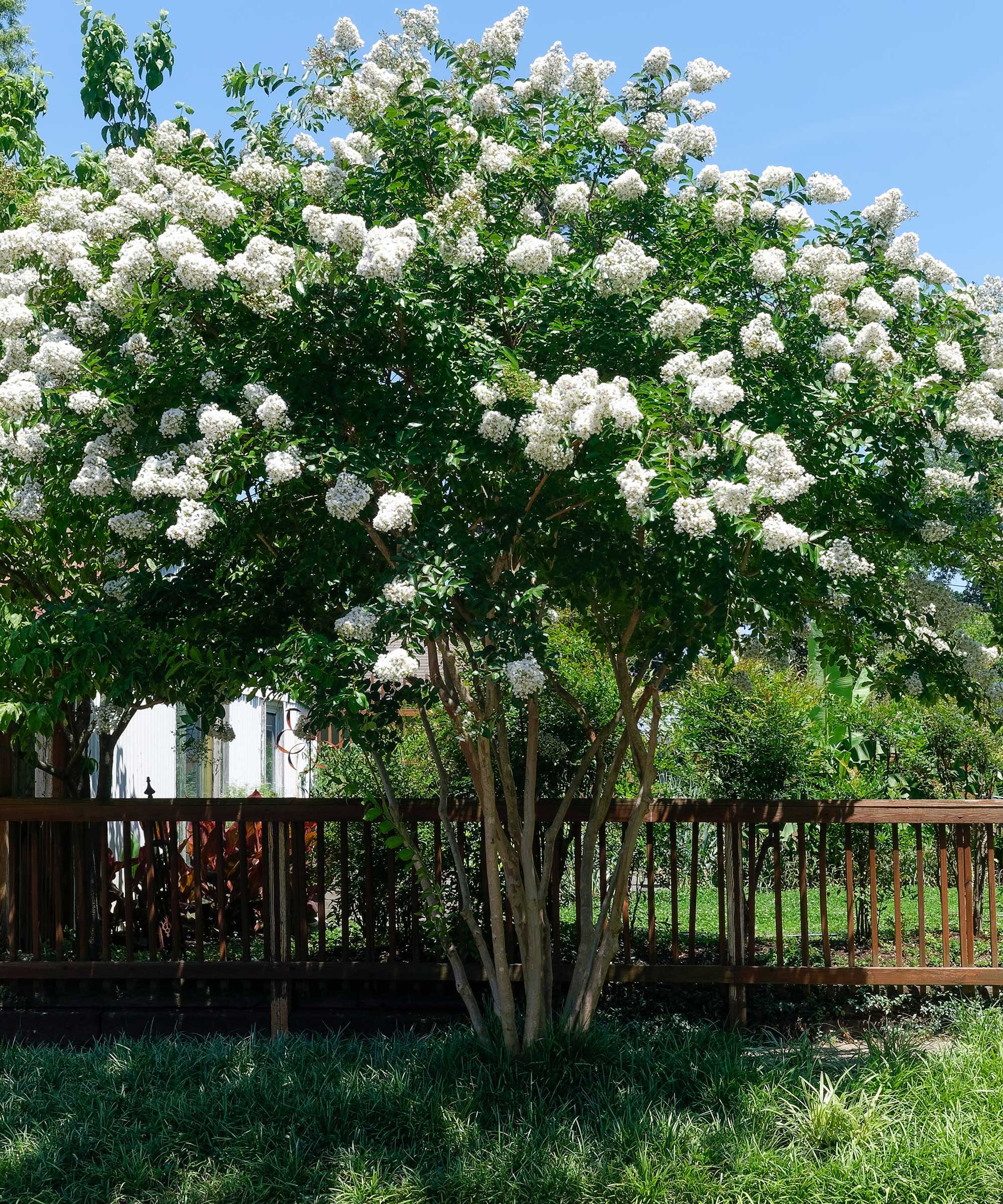
Don't plant your crepe myrtle in the shade
How to plant crepe myrtle
There are a few important things to remember when planting a tree to get the best results.
Plant crepe myrtles in late fall, in early spring, or in winter in frost-free zones. If you buy a plant in full bloom and plant it in the summer, be prepared to irrigate regularly to prevent the roots from drying out.
- Before you start, water your new crepe myrtle with a liquid fertilizer intended for lime-hating plants – one designed for rhododendrons and azaleas is ideal (try Amazon for a selection). This will help set it off with a flying start.
- Dig a hole three times as wide as the pot your new crepe myrtle is growing in and only a little deeper. Crepe myrtles tend to have widely spreading roots, rather than deep roots.
- Loosen the soil in the base of the hole, add about two inches of lime-free bagged garden soil or composted bark, and use your garden fork to mix it in. Set your plant in the hole and add or remove soil so that the top of the soil in the pot is level with the surrounding soil.
- Remove the plant from its pot, stand it in the hole, mix more garden soil with the soil you removed to make the hole, then use it to fill in around the roots of the plant. Firm well with the toe of your boot, adding extra soil if necessary.
- Irrigate with more azalea food, then mulch with 2in of composted bark or bark chips.

Feed your crepe myrtle when you plant it
How to care for crepe myrtles
Crepe myrtles are easy-to-grow and generally undemanding plants that do not need much care and attention.
Your new crepe myrtle may have been trained as a single trunk, to develop a tree-like silhouette, or with up to seven or eight stems to create a multi-stemmed, bushier look. Continue to treat your plant in the way the nursery started.
In their first year or two after planting, make sure that the roots do not dry out. Later in life, they may need irrigation in exceptionally hot and dry summers, but the plants are generally drought-tolerant once established.
Light fertilizing helps growth develop, especially on poor soils. Use Holly-tone (available on Amazon), or another shrub fertilizer that suits azaleas, in spring.
In zones 6 and 7, unusually cold winters can damage your crepe myrtle, killing some of the branches – occasionally killing the plant to ground level. But unless the cold period is long, and exceptionally fierce, new shoots will usually appear from the roots the following spring.
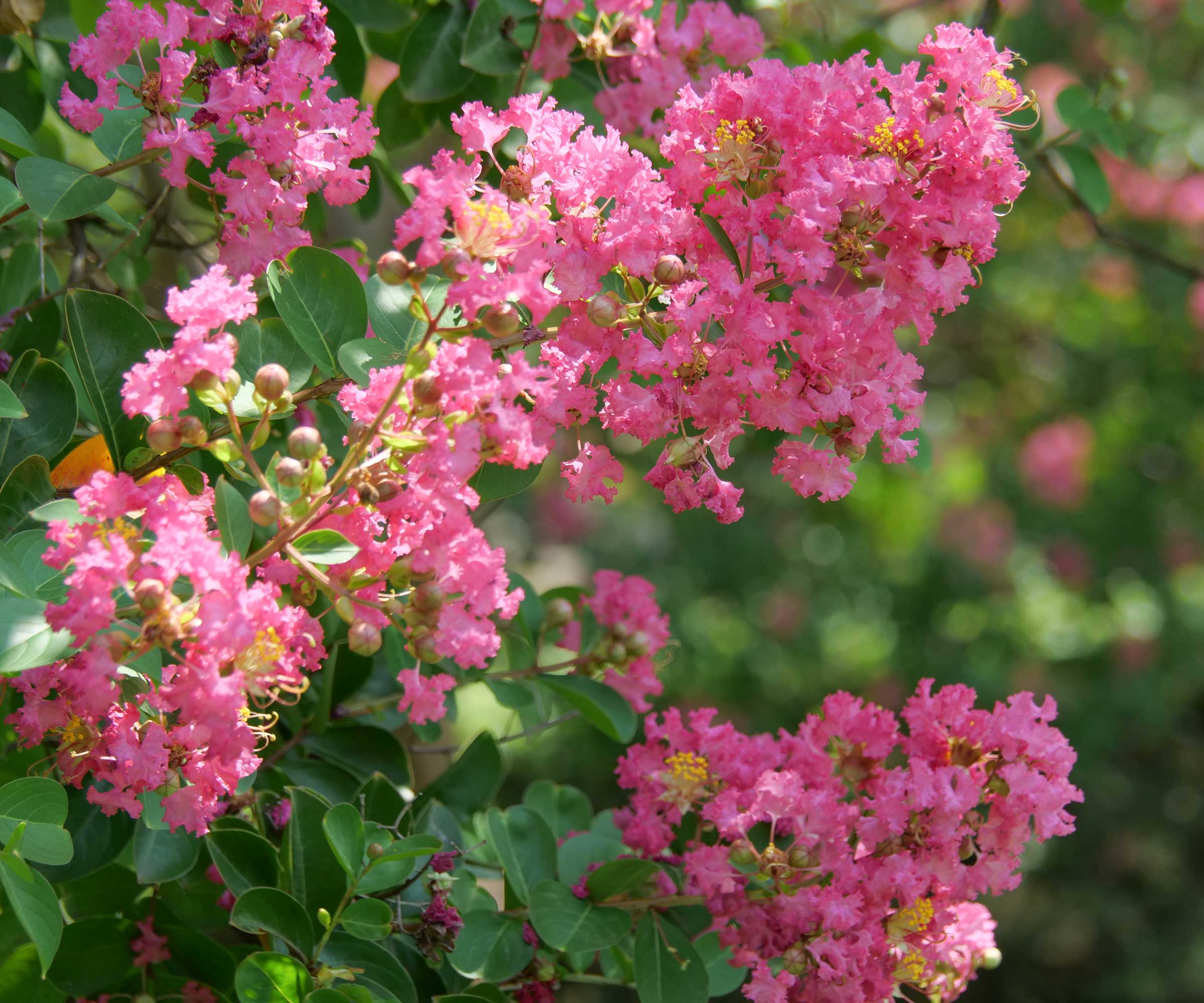
These trees are generally low maintenance
Pruning crepe myrtles
Incorrect pruning can result in crepe myrtles not blooming, so it's important to get it right to enjoy their colorful display.
Crepe myrtles flower in summer, at the tips of shoots that have developed earlier the same year. However, unlike roses and butterfly bushes, for example, which flower in the same way, they do not respond well to hard pruning in spring.
Smaller plants can be deadheaded promptly after flowering and this will extend the flowering season. In spring, dead, diseased and damaged wood can be removed using pruners or a pruning saw, including branches that have been damaged or killed by an unusually severe winter. Unwanted shoots that spring from the base can also be removed.
Overcrowded growth can be thinned by occasionally cutting out a mature shoot at the base to create a more elegant look, but it is usually a mistake to cut back hard into old growth when pruning crepe myrtle.
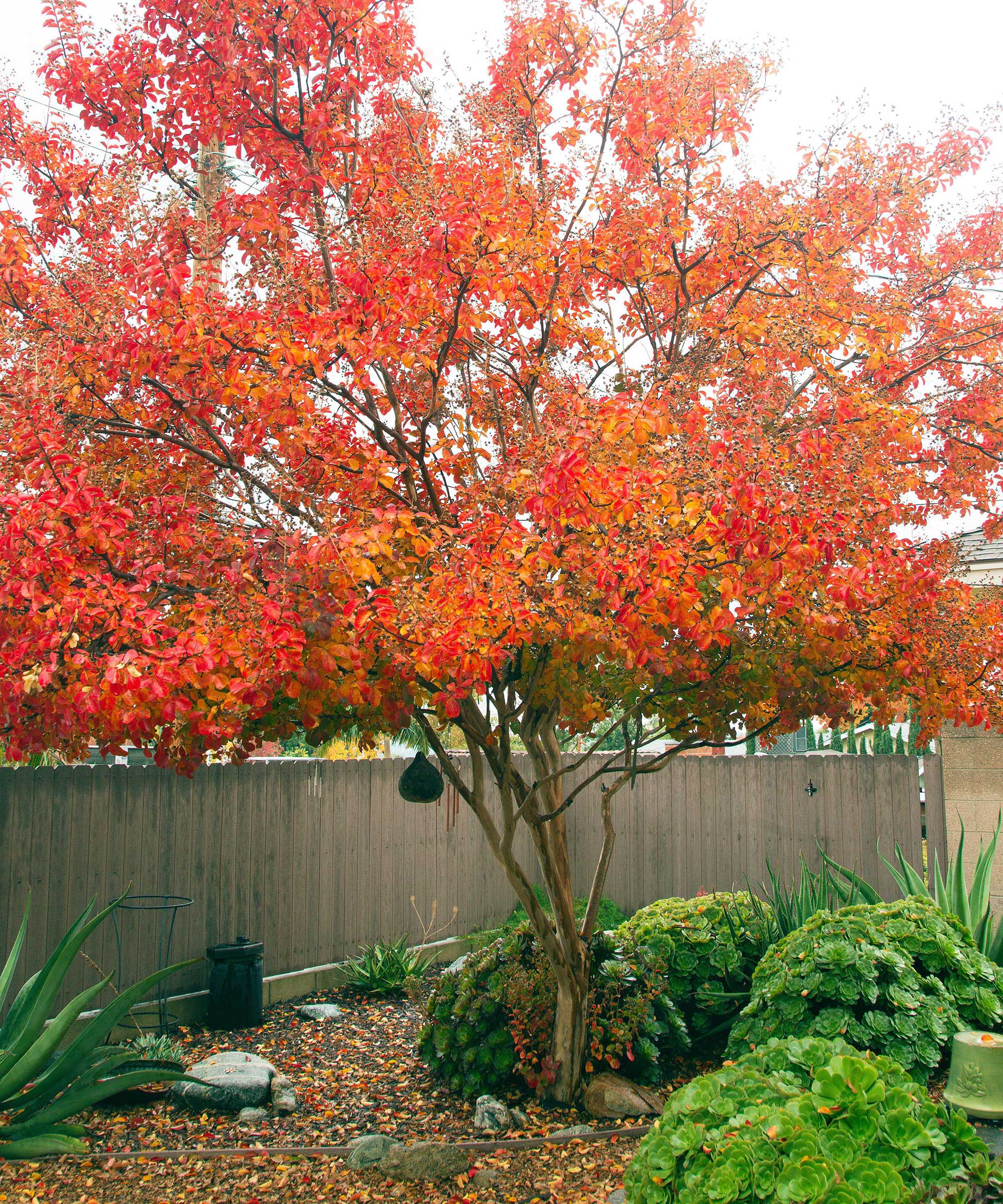
Remove dead and diseased branches in spring
How to make more crepe myrtles
The easiest way to make more crepe myrtles is to grow new plants from cuttings in late fall. No special equipment is needed in warmer zones.
Using sharp pruners, cut pieces of stem that have grown earlier in the year. They should be about 8in long and not more than 1/2in thick. Trim the top just above a bud, and the base just below. Fill a 5-6in diameter pot, which will take six cuttings, with moist potting soil, and tap it on a hard surface to settle it. Then, push each cutting into the soil so that about a quarter of its length is above the surface. Water well, then place the pot in a bright but sheltered place outside.
In areas where a winter frost is likely, place the pot of cuttings in the most protected place you can find. A screened porch or sunroom is often suitable.
When shoots start to develop the following spring, and roots emerge from the base of the pot, the pot can be moved to a bright and sunny place. Do not allow your rooted cuttings to dry out. When growing well, the rooted cuttings can be removed and planted individually, or moved into separate pots to develop before planting in the fall.
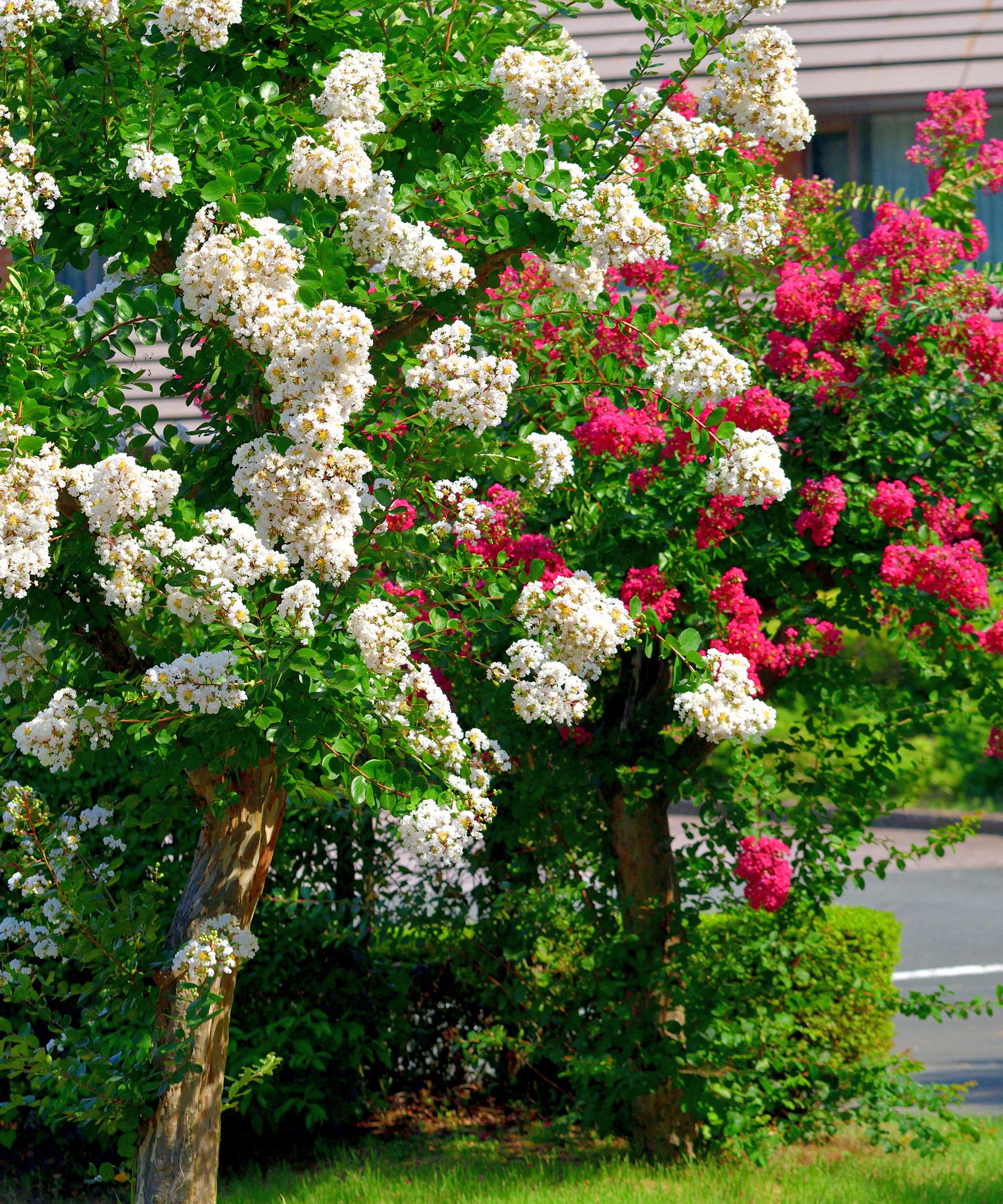
You can propagate crepe myrtles from cuttings
Solving problems with crepe myrtles
There are three crepe myrtle problems that you might come across: mildew, leaf spot and aphids.
Mildew: Powdery mildew is the most widely-seen problem, although the advent of mildew-resistant varieties is steadily changing the picture. A dusty, powdery white coating will form on infected plants. White spots appear first on the upper leaf surfaces, then the spots merge together and spread to the undersides. The leaves may dry up, turn brown and drop off.
One important thing to keep in mind is that, although they mainly look the same, the mildew that infects your crepe myrtle will not spread to your roses. Individual types of plants usually have their own individual mildew. Sprays are available to treat mildew, but planting resistant varieties is the best prevention. Many modern varieties of crepe myrtle are resistant to mildew – older varieties are more likely to be susceptible. Check tags or online descriptions carefully.
Leaf spot: Sometimes known by its scientific name Cercospora, leaf spot disease shows as small yellow or tan spots on the upper surfaces of the leaves, usually starting in mid-summer, with corresponding gray patches below. As the spots merge, the whole leaf may turn yellow or red – almost like premature fall color – before the leaves drop off. The damage may start low on the plant, and travel upwards. Leaf spot can be especially troublesome in warm wet seasons, and most of the foliage may drop off.
Prevention is best. Most modern hybrids are resistant, so start with one of these. When irrigating, do not use a sprinkler or spray that dampens the leaves, as this encourages infection. Clear up and burn all infected leaves. Check with your local extension service for details of the best, safe fungicide treatment.
Aphids: Crepe myrtle has its own unique aphid that feeds on crepe myrtle and never on other plants. These small, pale yellow, sometimes black-spotted little insects suck sap on the undersides of the leaves but rarely cause significant damage. Most gardeners tolerate them, but they can be treated with an organic insecticide.
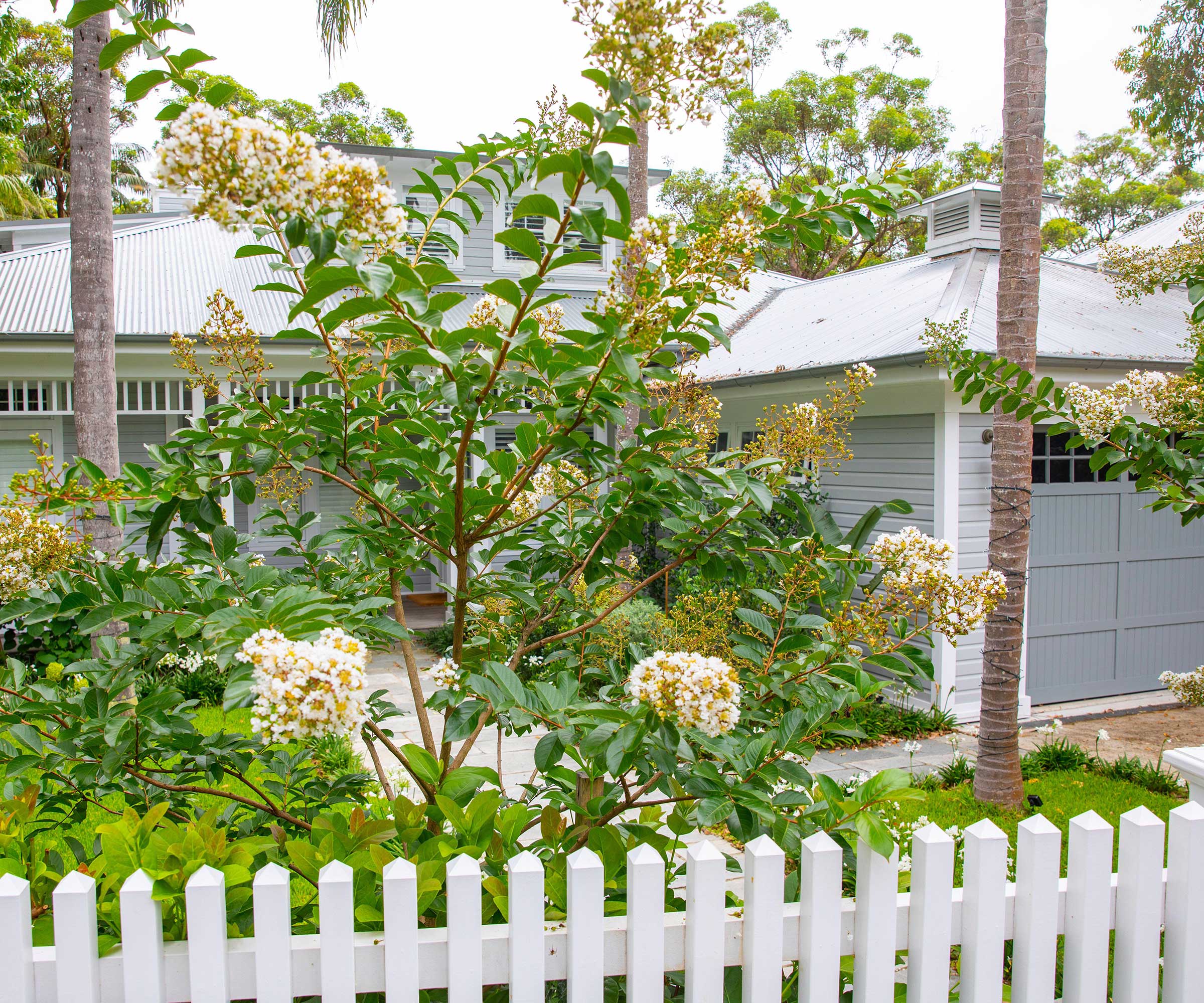
These trees make an eye-catching feature in a front yard
Are crepe myrtles deer resistant?
After careful research among horticultural and landscape professionals of all kinds, the New Jersey Agricultural Experiment Station has rated a wide range of plants for their resistance, or susceptibility, to browsing by deer.
Plants are placed in one of four categories and crepe myrtle is rated as 'Seldom Severely Damaged'. This is the second most resistant category of the four, meaning deer will not usually eat crepe myrtle but will do so if there is little else on which to forage.
Are crepe myrtles invasive?
No, crepe myrtle is not an invasive plant. It does not appear on any state or national invasive species lists.
Weeds shed from garden plants may sometimes sprout, but this is not considered a problem.
What’s the best fertilizer for crepe myrtles?
As mentioned, Holly-tone, or any fertilizer intended for rhododendrons and azaleas that you may already have, is good for crepe myrtles. There is also a granular formulation created especially for them – Nelson’s Crape Myrtle Food, available on Amazon.
How fast do crepe myrtles grow?
In general, crepe myrtles are moderate to fast-growing trees, and the plants are often long-lived. However, growth rate depends partly on the suitability of the situation in which the plant is growing, but more often on the characteristics of individual varieties.
Some crepe myrtle varieties can take many years to reach 4ft in height, while strong-growing varieties may reach 20ft in the same time. Always check the tag or the online description of the variety for details of vigor and anticipated size at maturity.
The experts at Florida’s Crape Myrtle Company say: '"Basham's Party Pink’ is the fastest-growing crepe myrtle tree we have ever seen. It is not unusual for ‘Basham's Party Pink’ to grow 12 to 15 feet per year! It is a very full upright tree that grows to 30ft+ tall with a 20ft+ canopy.'
A growth rate of 3-5ft per year is not uncommon. 'Red Rocket' is another of the fastest, growing up to 8ft per year.
How and where to buy crepe myrtles
Crepe myrtles are offered at the garden departments of DIY stores, at walk-in nurseries, at garden centers, and at other retail outlets, often in summer when the plants are blooming. They may be offered in two- or three-gallon pots or sometimes as larger specimens. They look very tempting. Choose a plant with an evenly balanced shape.
A wider range is offered by mail-order suppliers. The sizes available range from tubes, at the smaller and less expensive end of the range, to the two- and three-gallon sizes often supplied, and specimen plants in 15-gallon containers.
Keep in mind that when you spend more on a larger plant, you are buying time – some of the time needed for your plant to have an impact has already passed. With smaller, less expensive plants, patience is more necessary as your new crepe myrtle develops.
- Shop crepe myrtles at Fast Growing Trees
- Shop crepe myrtles at Nature Hills
- Shop crepe myrtles at Amazon

Graham Rice is a garden writer who has won awards for his work online, and in books and magazines, on both sides of the Atlantic. He is a member of a number of Royal Horticultural Society committees and the recipient of the 2021 Garden Media Guild Lifetime Achievement Award. He gardened in Pennsylvania for 20 years, but has recently returned to his native England.